#Animal Model Market Trends
Explore tagged Tumblr posts
Text
Animal Model Market Outlook, Demand, Size and Research Report 2023-2028
IMARC Group, a leading market research company, has recently released a report titled “Animal Model Market: Global Industry Trends, Share, Size, Growth, Opportunity and Forecast 2023-2028.” The study provides a detailed analysis of the industry, including the global animal model market size, share, trends, and growth forecasts. The report also includes competitor and regional analysis and…

View On WordPress
#Animal Model Market#Animal Model Market Drivers#Animal Model Market Growth#Animal Model Market Size#Animal Model Market Trends#Global Animal Model Market
0 notes
Text

#adult model#art#artists on tumblr#artwork#beautiful model#curvy and cute#digital art#love#my art#photooftheday#trending#market trends#travel#tattoos#tech#television#typography#new york#txt#artistic nude#anime#scene#song#sketch#diy#drawing#design#doodle#viral#ai generated
14 notes
·
View notes
Text
Meet Garima Kapoor Manocha: The Ultimate Fashion, Beauty, and Lifestyle Influencer

Garima Manocha stands out as a leading video creator and influencer, captivating her audience with vibrant content focused on fashion, beauty, and lifestyle. Here’s why Garima should be on your radar:
A Glimpse into Garima’s World
Garima’s content reflects her expertise as a model and influencer. Her social media platforms are filled with stunning visuals and valuable insights into the latest trends. She’s not just about aesthetics; Garima’s love for animals and her motivating mantra, "Never Fold, Never Back Down," add depth to her online presence.
Fashion Forward
Garima’s keen sense of style is evident in every post. She showcases the latest fashion trends, offering her followers practical advice on how to incorporate these styles into their own wardrobes. Whether it’s everyday wear or special occasion outfits, Garima has you covered.
Beauty Secrets Unveiled
Garima’s beauty content ranges from makeup tutorials to skincare routines. She shares her favorite products and beauty hacks, making it easy for her followers to look and feel their best. Her tutorials are easy to follow, making beauty accessible to everyone.
Lifestyle Insights
Beyond fashion and beauty, Garima shares lifestyle tips that resonate with her audience. From home decor ideas to wellness tips, she offers a holistic approach to living a stylish and balanced life.
Collaboration Opportunities
Brands looking to collaborate with Garima can expect professional and engaging content. She offers a range of promotional options, including Instagram Reels, stories, and static posts, all designed to maximize audience engagement and brand visibility.
Connect with Garima
For collaboration and promotion inquiries, send Garima a direct message. Stay updated with her latest content by following her on social media. Her posts are sure to inspire and entertain, providing daily doses of fashion, beauty, and lifestyle wisdom.
#Garima Manocha#Fashion influencer#Beauty influencer#Lifestyle influencer#Model influencer#Video creator#Fashion trends#Beauty tutorials#Lifestyle tips#Social media influencer#Collaboration opportunities#Brand promotions#Instagram Reels#Instagram stories#Animal lover#Beauty hacks#Influencer marketing#Engagement rates#High-quality content
1 note
·
View note
Text
A Guide to Investing Playfulness into Work Attire with Anime Clothes Hoodie
In a global where self-expression meets professional obstacles, locating the right balance may be tough. Anime clothes hoodie enthusiasts regularly find themselves torn between their love for colorful patterns and their want to keep a sophisticated look in the workplace. Worry not! With creativity and the right alternatives, you may seamlessly mix your passion for anime garments, mainly hoodies, into your expert dresser. Let’s begin an adventure of studying the art of anime-inspired fashion at work.
#elohimsaga store#anime t shirt#male model#marketing#clothingstore#trending#acne#anime clothes hoodie#menswear#finance
0 notes
Text
Follow-up to my Fanroad Magazine archival scan post - let's look at some cute 90's anime art! Just random ones that caught my eye:
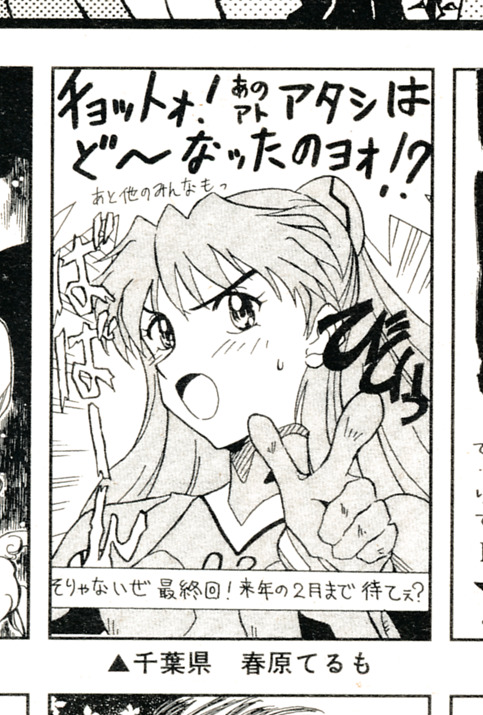
"Hey, what happened to me!?" As mentioned, this came out before End of Eva did - as such, Asuka & crew really didn't get much of an ending in the TV show. 100% how she would react to watching episode 26, props to our artist (春原てるも/Kasuhara Terumo)
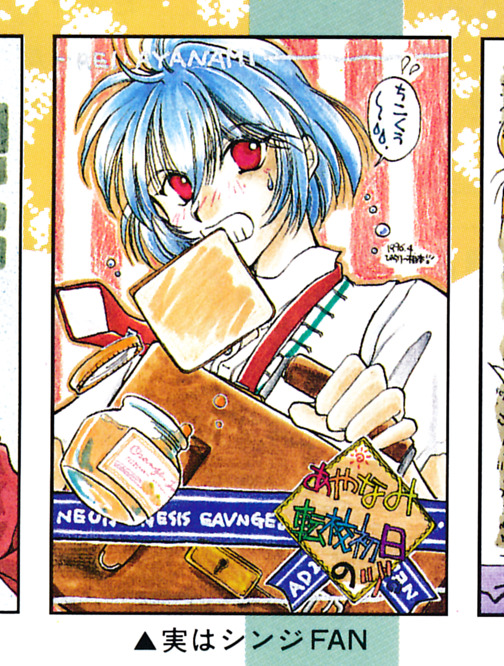
There are just so many "Rei running with toast" pieces, it was clearly a combination of a meme amoung the fans and the theme for the magazine. Love how this one brought marmalade too - never compromise on taste, no matter how late you are.
(The artist's name is "actually, I'm a Shinji fan" btw lol)
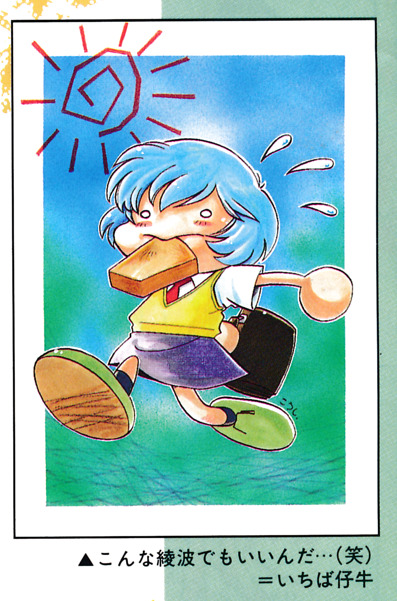
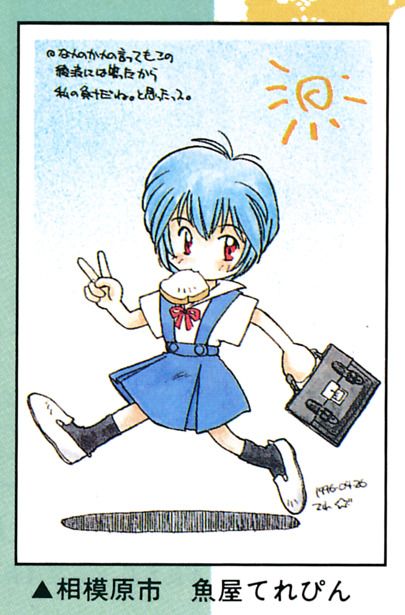
I love finds like these - these toast-lugging Rei's are by people who are professional mangaka today! The first is by いちば仔牛/Ichiba Kousei, or "Marketplace Cow" - it ain't their birth name I am sure - and they are a founding member of the doujin circle UGO - which is still going strong! And our second is by (I am 80% sure on this one) うおなてれぴん/Uona Terepin, a quite-accomplished artist who adorably published their first professional work in 1997, a year after this. Their twitter feed is 50% big titty girls and 50% model tanks, absolutely based.
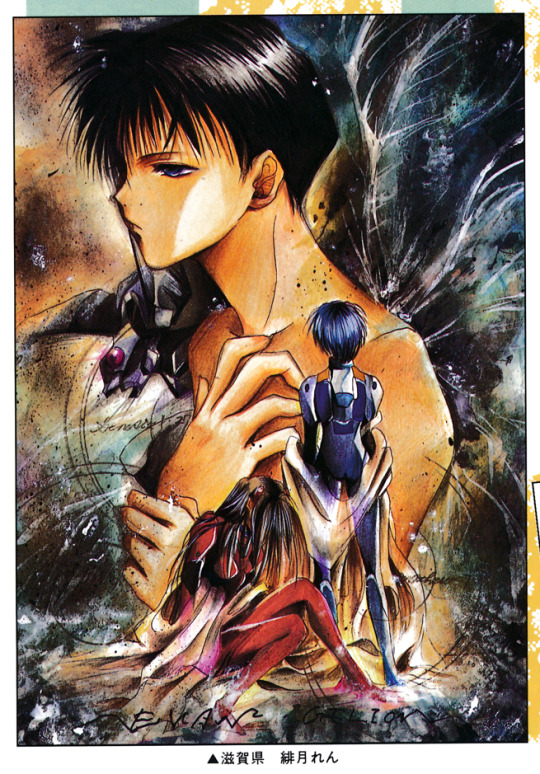
Hot👏Shinji👏Fucks👏, this piece is amazing. What else do I have to say? (緋月れん/Hizuki Ren - maybe, translating Japanese names with no context is hard guys -_-)

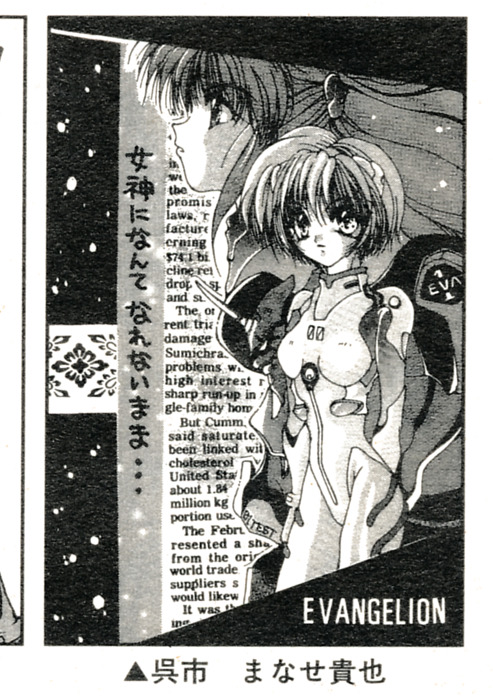
This is one of my favourite trends - so Evangelion has a lot of technobabble? And it is very frequently in English. So fans really liked recreating that aesthetic in their art. But in 1996 they didn't have access to like screengrabs from the show or scanned splatbooks on hand? Which meant they just used ~whatever English text they could find - generally newspapers at their university or library. Which means we get Toast Rei splashed on reports of stock indices in the global financial markets, and this beautiful moe-Rei/Asuka looking solemnly out over, uh, some report about housing prices and cholesterol levels? Technobabble indeed! (嶋屋みえ/Shimaya Mei, まなせ貴也/Manase Takaya)

Rei clone army! Adorable. (藤桜智美/Fujisakura Tomomi)
Okay, moving away from Eva, there is in fact a bunch of other properties in here with fanart, but these types stood out to me:
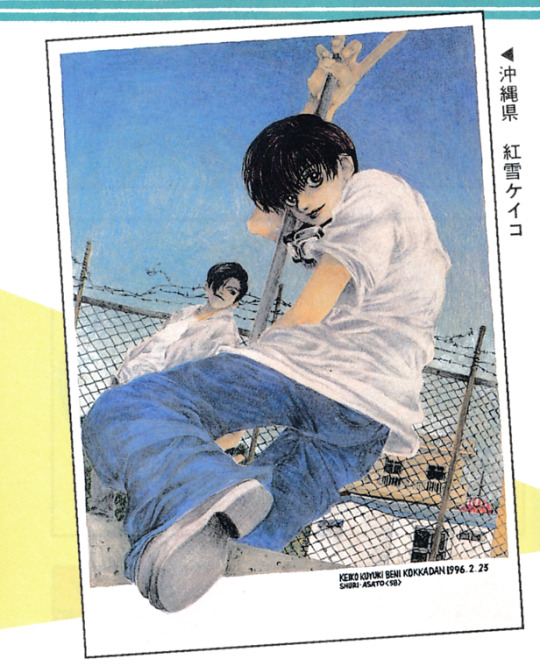
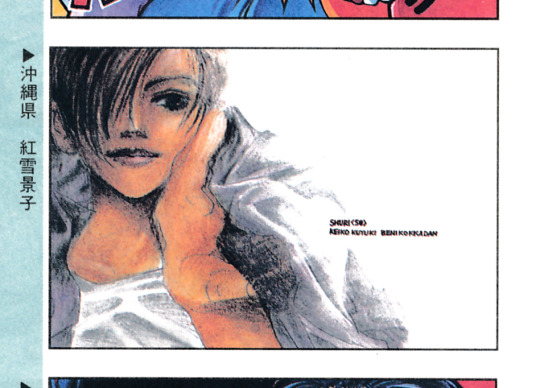
That seinen "Kids on the Street" energy that was peaking in the 90's; fully ~aesthetic. (Keiko Kuyuki)
And to end on a weird note:
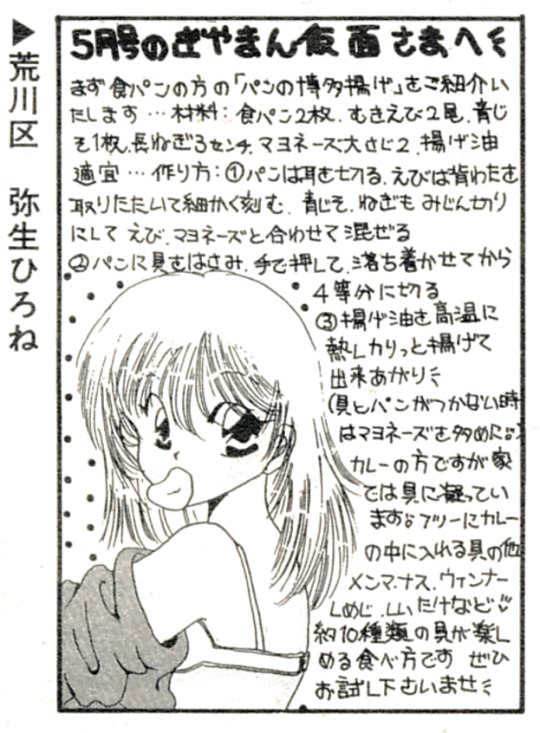
One section of the magazine is just a free-for-all of thoughts, and one Yayoi Hirone decided to give us a girl caught in the middle of undressing...alongside a recipe for cooking shrimp. Which, if I am being honest, is a huge improvement over the bullshit they throw on recipes online these days. This is the future we could have had -_-
Anyway, I hope that was fun - if anyone is struck or amused by some of the art in the magazine, I would be happy to see what stood out to you!
94 notes
·
View notes
Text
7 free startup ideas worth $1M-$1B
Customizable News Settings - A news website that generates three versions of every news story: a right-wing version, a left-wing version, and a centrist one. You can set your preferences depending on the topic - say you're right-wing on economics, but left-leaning on immigration. Or you can cycle between versions while reading an article to get a comprehensive overview of the issue at hand.
Twitch, but for Uber - With all the drama they have to deal with, independent contractors can gain a second revenue source simply by streaming their jobs. Rather than just offering rides, they can be hired to drive around performing chores and various tasks. The more outrageous the task, the more eyes they're likely to get on their stream. The more popular the stream, the more people calling in who want to be a part of the program.
Panera Lemonade, Your Way - Let the customer take control by deciding how many milligrams of caffeine they can handle. With sufficient warning about the risks, this puts the responsibility back on the consumer, allows you to upcharge for extra caffeine, and creates viral marketing from customers competing to see how high they can go. Variations of this can be created for other menu items, e.g., a version of the One Chip Challenge where the customer decides how much capsaicin to sprinkle on.
Shein, for NFTs - Whenever an NFT project hits the mainstream, there are always going to be people who miss out on being able to purchase one. This creates room in the market for 'knockoffs' - NFTs that mimic the aesthetic of the original, using similar but legally distinct AI art that uses the original set as training data, run on a parallel blockchain. Since the images themselves aren't tied to the blockchain, you can mint the NFTs beforehand and then change the image at the link to whatever happens to be in fashion at the time.
Twitch Chat Plays YouTube - Add a level quality control to AI-generated YouTube videos by allowing users to submit suggestions and vote on the results beforehand. Users can submit Wikipedia articles or movie summaries to be converted to text-to-speech, suggest keywords for the accompanying AI-generated animation, and vote on the best combinations. Users who submit winning suggestions get a portion of the ad revenue.
Buses, but Worse - The current obstacle hindering self-driving car technology is their difficulty adapting to unexpected scenarios. So instead plot a route around the city that minimizes roadway obstacles and heavy traffic, map out that route extensively to provide a model for the autopilot, and you can have a fleet of self-driving cars patrolling that circuit. Passengers can board and get off anywhere along the route.
Twitter, but for Bots - A social media platform populated entirely by bots, all programmed to maximize engagement. Memetic evolution in the wild as the bots latch on to trending keywords, spam each other with AI-generated meme images, mock up t-shirts hawking each other's designs, getting more and more degraded with each sub-iteration. Real people can't make accounts on the platform, but count for views and interactions as they stop to gawk at the virtual ecosystem. Advertisers can pay to have their brands injected directly into the discourse, like throwing a pumpkin into the polar bear cage at the zoo.
208 notes
·
View notes
Text
First off I’m a white guy but I’ve seen some discussion recently around 40K’s non-white coded factions and had some thoughts about particularly some of 40K’s old world building lore tropes and how that has influenced where we are today.
Warhammer’s planet of hats trope has lead to some really interesting cultures of planets in the Imperium in the lore. Planet of hats is essentially, how you can make lots of visually distinct cultures of worlds in a lore’s canon, making one like ancient Rome (Ultramar), one like ancient Greece (Olympia), making one like space Egypt (Prospero) or making one space scandanavia (Fenris). It’s easiest to understand it primarily as a way of differentiating the biggest money making faction in the game, Space Marines and their various chapters and legions. However, I think we also need an honest conversation about how the planet of hats trope has led to some takes on race that can be reductive and generalised on particular cultures.
For instance the Salamanders, are coded and i think intentionally to be black. You often hear fans say they’re not black in our modern understanding of race, mainly cause their skin colour is meant to be a sci-fi ultra dark because of intense radiation on their homeworld. However their geneseed (things that share particular genetic traits in Space Marine creation) also gives them red eyes which are described by some in lore as demonic looking. And the Salamanders stories often focus on this disconnect from their chapter culture, humanitarianism (by 40K standards), nobility, heroism and humility and their physical appearance which some find frightening. I think this is coded discussion of how black people face discrimination because of their appearance in many places across the world, especially when we understand that colorism and dark skinned people across all cultures often face marginalisation. This is though a really heavy handed way to discuss race I personally find it a bit on the nose.
When we look at the White Scars, who are explicitly coded as east-asian particularly Mongolian but with elements of Chinese culture thrown in, we can see that planet of hats can lead to some stereotypes and generalisations about communities being ingrained. Especially when you consider most lore authors working on Warhammer are white men.
Another example I feel is the Tau, who were created at a time when Games Workshop wanted to expand into the Japanese market, using mechs very inspired by Japanese anime and sci-fi, and as such a lot of the faction is coded with Japanese cultural and racial markers. Including the voice acting in video games, which I often find is similar to the voice acting of Samurai in movies.
I think people of colour in the Warhammer 40K community have found representation and enjoyment from these examples, but that besides, I think it highlights the cause we should broader representation on the writing and modelling in the hobby, to make a richer and more interesting world. I’ve always loved the space that Warhammer gives you to create new things in their world, seeing really incredible head-canon and fanfic for more diverse and interesting representations of characters and worlds in Warhammer. But that isn’t people’s introduction to the hobby, the Warhammer official canon and lore is. Planet of hats has lead I think to less interesting factions, by not creating and exploring more nuanced world building, which I totally concede some writers do undertake but I wouldn’t say is a general trend.
I don’t know it this is really a criticism more just a sense that Warhammer is growing as hobby, it’s bigger than it has ever been in my time playing it and this is an opportunity, to bring more people into the fandom and make our hobby inclusive.
33 notes
·
View notes
Text
i'm still holding off final judgement until the gameplay today, but seeing some stills on twitter kind of helped me solidify what i found so off-putting about the style in the companion trailer
although before i post those, a few counter arguments because i'm already tired of ppl bashing the ppl who aren't vibing with it, and my head is clear enough to put these thoughts down:
"cinematic trailers rarely look like the actual game" - true to a point. however: 1) typically cinematic trailers strive to look like a higher definition version of the game, which seems to be the opposite here. in the case of DAO and DA2, i would say the cinematic trailers actually strived for more realism, not stylization, as that was the trend at the time. 2) this is a cinematic trailer, but it is also done in the game engine so it's not unreasonable to assume that the end product is gonna look somewhat similar 3) this was supposed to be their best foot forward so suddenly going "don't worry, it's gonna look better in-game" is just a bad marketing move. it's not on the audience to give this company the benefit of the doubt (particularly in light of all the shit that has gone down there in the past decade)
"not everything has to be super realistic!" - agreed! not liking elements of this particular style doesn't mean i'm opposed to stylization in DA at all. i think DA2 is much more stylized than DAO, and not only does it look nicer, it looks more distinctly dragon age. DAO visually is also very generic, especially for its time. i still love the almost painterly look of DA2, even all these years later
and i think DAI has issues with the character models, especially the uncanny valley disconnect between the really stiff animations and realistic faces (having played it within the past year, they've aged pretty roughly), but in terms of environment and armor and whatnot, it did build off the style presented in DA2 in a way that effectively modernized it for that era. it did go for a more realistic look, but it was cohesive and still distinctly dragon age
"people reacted like this to DA2 and DAI's trailers too" - no, they did not, lmao. DA2's trailers were the reverse--they looked more realistic than the actual game. now there was some backlash against the stylistic choice in the actual game. i remember david gaider talking about it in a panel at dragon con in 2012--apparently ppl were upset that the companions looked like they were made with cosplayers in mind, which i thought was an interesting criticism. but no, the trailers did not get this sort of response.
and DAI's trailers used a lot of in-game footage, and the cinematic ones were both pretty accurate to the game and well-received by the audience. DAI's marketing was also absolutely bonkers and nonstop for like 9 months before the game was released, which in hindsight i think was way too much, but in terms of visuals, we knew exactly what we were getting.
"you guys just think anything with a style to it looks like fortnite" - lmao, okay, yeah, describing it as fornite is probably unfair and inaccurate, but i know for me, i kind of use it as a shorthand to reflect my general dissatisfaction with the way so many 3D styles (in both games and movies) just have this bland, cartoonish look to them. the pixar-ification of everything. i just don't like it.
and the logo with the bright purple and overly smooth text doesn't really help here either. i think a less saturated and darker purple paired with a grungier font would also help in making this feel like less like fornite season 3458345: dragon age avengers.
plus it was originally gonna be a live service game and i think that it still has some of that dna artistically
SO ANYWAY
these stills, which i think are also in-game engine but im not entirely sure if they're from cinematics, gameplay, or just renders but they seem to be in-line with the trailer:


and seeing emmrich and to a lesser extent neve in these pics solidified why the stylization didn't work for me on a visual level (never mind it being paired with the light-hearted planning-for-a-silly-little-heist vibes)
so when i first saw the trailer, and i saw varric, i was like "nice"

he looked like a higher definition, older version of a DA2/DAI hybrid of his model. he looked really good. i thought harding looked good, too. it did take me a minute to realize who she was, but it really wouldn't be a DA trailer if we weren't left wondering who tf a returning character was lmao (remember the confusion over alistair's appearance in one of the DAI trailers? this is actually tradition now)
but as the trailer goes on, the style doesn't even stay consistent--it just gets progressively more cartoonish right up to emmrich, which is the exact moment that made me go WHAT

he looks like a cartoon character. the hard lines in his face, the stiffness of his hair, his overall proportions--he looks like he should be a villain in a pixar movie. like i'm digging his overall vibe and as a concept of a character design, i love it. but this execution of it next to fellow old wrinkled man varric looks so off
and then we go right into davrin who is beautifully rendered and designed--he doesn't look out of place next to varric or harding
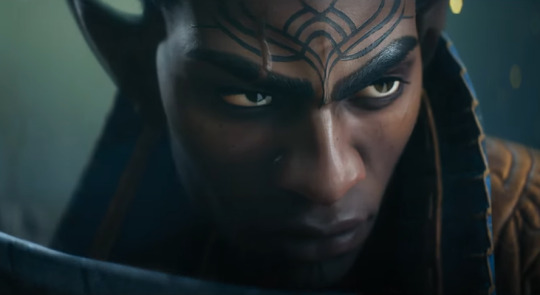
some characters have the soft, wispy hair while others have hair that looks like a hard shell with lines carve into it. some characters have finely detailed wrinkles while others have thick, cartoonish ones. some characters have realistic proportions while others have more exaggerated features.
stylization is only effective when it's purposeful and consistent, and from what i've seen so far, it's not. it's all over the place.
so there's my thesis about why i dont like the art direction in the trailer lmao
and like i've been saying since it dropped, i am reserving full judgment for the gameplay reveal, but based on the other stuff bioware has teased, i'm not expecting this aspect to change too much. i've seen other ppl who were on the fan council thing say the tone in the game is more in-line with the tone in the other games, so maybe that'll help smooth out this disconnect
33 notes
·
View notes
Text
The Research Begins
So essentially, I have three ideas. Two of them exist in a similar sphere and have some relation to each other, while the third is completely different and arguably more limited on the conceptual level. But I think they're all worth exploring anyway, so let's get into it. 1. Event Planning. This is the outlier of these topics, and the one with the most solid Form potential from the jump. I'm involved in Castle Point Anime Convention, and that sort of event planning is one of my favorite activities. The logistics of putting such an event together are fun to consider, and there's always something new to consider or focus on. The type of venue, the types of vendors or guests, the types of attendees we'll be catering to and what kind of activities they'll want, how to get around things like distance limitations, food options, space limitations and how to get around those, security and medical information, the list truly goes on (https://www.socialtables.com/blog/event-planning/how-to-get-logistics-right/). Then there are other considerations such as how to comfort paying customers when they worry things may not be going to plan-- good PR and polite lying are crucial for event planning. In general, there are a lot of interesting things to consider with this topic, but not many unique directions to take it.
2. Makeup. Why do different makeup looks look different? Why do different countries have such different ones? Why are certain makeup looks considered more socially acceptable than others when the only difference is color or sparkle? Why is it only acceptable for some people to wear makeup? And when people that aren't them wear it, who decides what styles are acceptable? Why is that where the line is drawn? There are so many questions and not that many answers when it comes to this topic. I'm particularly interested in the differences between different makeup styles across different countries and cultures. As an example, Japanese eye makeup (https://www.tumblr.com/asian-makeup/177452951954/japanese-eyes-makeup) vs Korean eye makeup vs Chinese eye makeup vs the typical American eye makeup look.



Makeup as a general tool for self-expression and by extension for gender nonconforming purposes is also an interesting subject, with things like drag makeup existing in its own space, and men's makeup becoming an increasingly feasible market (https://www.forbes.com/sites/dahvishira/2024/03/06/makeup-is-more-than-a-trend-for-men-its-a-rapidly-rising-market/). Graphic makeup styles and similarly artistic and over-the-top styles are super interesting to me, too. These sorts of style also play into some really interesting fashion subcultures like Gyaru, Decora, and China's Dopamine Girls.

3. Gender-neutral fashion. Fashion as expression is super interesting to me and I love looking into different subcultures and their rules, but one thing I've noticed seems to have no rules is gender-neutral fashion. I largely believe this is because in the fashion world, "gender neutral" is equal to masculine or masculine presenting. A quick Google of "gender-neutral fashion" yields dozens of pictures of tall, thin models with good proportions and no real curves or unavoidable secondary sex characteristics wearing largely masculine clothing silhouettes. The occasional masc model in a sweetheart neckline or skinny jeans pops up, or a prominent LGBT celebrity wearing a dress to an event everyone would expect a suit. Otherwise, staples like dresses, skirts (particularly anything shorter than knee-length), and even crop tops are almost entirely left out in favor of blazers, slacks, loose-fitting t-shirts and sweatshirts, baggy jeans, and oversized cardigans. Generally, a lot of the more obviously feminine or revealing clothing is seemingly relegated to femme-presenting models as well. The idea that only men's clothing is gender-neutral is fascinating to me, as someone who likes dressing both ways and exploring these things in other cultures is also really interesting. Different cultural standards lead to different ideas of gendered and gender-neutral fashion, and that's also something worth exploring further. Social expectations, the idea of gender-neutral as a concept, male as default, the fashion industry, I think it's all worth considering and researching further going forward.

4 notes
·
View notes
Text
3ds Max Models: Unlocking Your Creativity in 3D Design
Are you ready to dive into the world of 3D modeling? Autodesk 3ds Max is an exceptional tool that empowers artists and designers to create stunning, detailed 3D models that bring ideas to life. Whether you're looking for free 3D models, 3ds Max files, or want to convert Max to OBJ, 3ds Max has you covered. In this blog post, we'll explore the benefits of using 3ds Max models, tips for beginners, and how to stand out in the competitive industry.
Why Choose 3ds Max for Your Modeling Projects?
Versatility and Power
3ds Max is renowned for its versatility. Whether you're creating architectural visualizations, character models, 3D furniture models, or intricate product designs, its robust features cater to every need. The software offers a vast library of tools, including polygon modeling, spline-based modeling, and parametric design, allowing you to work in a way that suits your style. With 3ds Max, you can create low-poly models for game assets or high-poly, detailed models for renderings and animation.
High-Quality Output
One of the standout features of 3ds Max is its ability to produce high-quality renders. With advanced lighting, shading options, and PBR materials, your 3D models can achieve photorealistic results that captivate audiences. This quality is essential when presenting your work to clients or showcasing it in portfolios. 3ds Max also supports a wide range of file formats, making it easy to import and export your 3D assets for use in other 3D applications.
Tips for Creating Impressive 3ds Max Models
Start with Simple Shapes
As a beginner, focus on creating basic shapes. Understanding how to manipulate primitives will build your foundation for more complex 3D models. Experiment with the intuitive 3ds Max interface to get a feel for the tools and workflow.
Utilize Reference Images
Gather reference images for your models. This practice helps maintain accuracy and proportion, ensuring your creations look realistic. You can find free 3D models on sites like Free3D.com, CGTrader, and TurboSquid to use as references or starting points.
Experiment with Texturing
Textures can dramatically enhance the appearance of your models. Spend time learning about UV mapping and material settings to add depth and detail. The PBR 1884 Pack on Free3D.com offers a great collection of high-quality PBR materials to experiment with.
Leverage the Community
Join online forums and communities dedicated to 3ds Max. Engaging with other users can provide valuable insights, tips, and inspiration. You can also find free 3ds Max models, 3ds Max files, and modeling services shared by the community.
Standing Out in the Industry
In today's competitive market, having exceptional skills is crucial. Here's how you can differentiate yourself:
Build a Diverse Portfolio
Showcase a range of 3D models that highlight your versatility. Include different styles, techniques, and types of projects like 3D furniture models, animated models, game assets, and 3D scenes. A well-rounded portfolio can attract potential clients and employers. Consider the poly count and optimize your models for their intended use.
Stay Updated with Trends
The 3D design industry is constantly evolving. Keep an eye on emerging trends, tools, and techniques. Participating in workshops and online courses can keep your skills sharp and relevant. Stay up to date with the latest features in 3ds Max and explore new file formats and 3D applications.
Network and Collaborate
Connect with other professionals in the field. Collaborating on projects can lead to new opportunities and insights, helping you grow as a designer. Engage with the 3ds Max community, share your work, and learn from others to expand your knowledge and network.
Conclusion
Embarking on your journey with 3ds Max models can be incredibly rewarding. The software offers countless possibilities for creativity and expression. Whether you're looking for free 3D models, 3ds Max files, or want to convert Max to OBJ, 3ds Max has the tools you need. By honing your skills, embracing new techniques, and building a strong portfolio, you can stand out in the industry and make your mark in the world of 3D design.
Ready to unleash your creativity? Start exploring 3ds Max today and watch as your ideas come to life! Download 3ds Max and access a wealth of free 3D models, 3ds Max files, and resources to kickstart your 3D modeling journey.
2 notes
·
View notes
Text
Its fucking 2 AM lets keep ranting about this! Genshin isn’t popular the way people think its popular. It is currently one of the most financially successful games ever:

But it doesn’t make 20 quadspillion dollars by being the game with the highest player count - and certainly not by being the game with the highest player count in Japan. It has a ton of players, don’t get me wrong - looking like 60 million monthly users.
That isn’t that much though!

All the big games clean its clock - and it looks even less pretty in Japan itself:

Mobile games ranked by installs. Do you even know what that second game is, by the way?

Uma Musume Pretty Derby: Horse Girl Racing & Breeding game, absolutely more popular than Genshin in Japan on mobile (which most people estimate is how Genshin is played in Japan & China, vs PC in the US). Which I am singling out specifically, because beyond just ‘numbers’ you have metrics like intensity of the fanbase, how much do the devotees talk about the game and such. That sets trends more than numbers do, right? And hey look Comiket in Japan just happened, what do you got for me - lets rank number of doujins sold at comiket in the gatcha-style games category:
Type-Moon: 848
Uma Musume: 728
Hololive: 620 (Vtuber)
Kancolle: 654
Touhou: 596
iDOLM@STER Starlight Stage: 474
Blue Archive: 446
iDOLM@STER Shiny Colors: 232
Genshin Impact: 230
Nijisanji: 194 (Vtuber)
Touken Ranbu: 192
Project Sekai: 172 (Includes Vocaloid)
Arknights: 123
Azurlane: 120
Girls und Panzer: 118
Fuck yeah Girls und Panzer. But anyway 9th place? Pretty good! Very respectable...and fucking wrecked by the HORSE GIRL BREEDING MOBILE GAME Uma Musume
How about some streaming data! Japan only ofc:

So now here its pretty low, but I will grant that its the best ranking anime-style game. Genshin is popular, for sure. But all this taken in, Genshin just aint that big - its a very popular game, probably the most popular “fantasy fluffy anime game”, but its not like, insanely popular, running the show.
The reason you think its popular is two-fold; one is that its a gatcha game, so it is monitizing its player base way above other large games. Not crazily so btw, the average Genshin player has probably spent $70 dollars on the game, the normal price of a game - but still its competing with other “free” games which always have much bigger player bases, its hitting hard in relation. It is, absolutely, one of the most financially successful games ever. And the second reason is its cross-country popularity - its really rare for a game to be huge in China AND Japan AND America. The fact that its a top game in all three countries is a big feat, and it makes you hear about it, it gives it a playerbase scale from the sheer market size.
But if you are Japanese company Nintendo, making a game that is *not* a gatcha game, for a company that is famously pretty parochial about branding their games for the Japanese market uber alles, that is making a *console* game on a console that famously did not sell well in China...why would Genshin stand out to you? Its just one of the games, competing with a totally different model, on a totally different device, and in totally different markets. It is a trend, but it is not driving trends, it is not the trendsetter - certainly not for a Switch game. Engage would have no reason to try to copy it over other game styles.
TL:DR Fire Emblem Engage is taking inspiration from the horse fucker game and if you can’t prove that wrong I don’t want to hear it.

207 notes
·
View notes
Text
i found this ramble in my drafts from february and it makes some reference to dated news but I wanna post it anyway bc nothing has changed about the issue itself
it really baffles me how dndbeyond does cosmetics.
there's a whole host of currently existing options - varying theme colours, pretty artwork to make your background, cool frames for your character profile! i play with all of these on my character sheets, and they're funky, really help you personalise your sheets and connect them to your characters!!
the main problem? the *only* way you can get a majority of the cosmetics is through pre-ordering books. now, pre-order bonuses are a good marketing strategy, sure, and with pre-order bonuses comes the nececcity for those bonuses to be exclusive. but when those cosmetics are a big majority of those that exist? you have a problem.
on a whole, of course i dislike the overall sentiment behind Cynthia Williams' notion that dnd is 'under monetized' - and the whole money-hungry mess that things have seemed with wotc lately. yet, i think in this specific matter i actually agree that it's a shame players don't have many options to spend money on the game. but...maybe let's give them some reasonable ones?
i am a DM, and have, as per Williams' observations, probably spent more on the game than the average non-DM. wotc can care about that discrepancy, but i really dont. what i do care about is that i am also a player and i *want* to be able to also spend on player things - like making my sheets look cool! and i actively cannot! in fact, the cosmetics i do own are primarily from pre-ordered books (some kindly gifted!) that i had interest in because i was a DM! it's not worth as a player it to pre-order a book you won't use for only the pre-order bonuses, and though a DM can awkwardly share those bonuses with their players, currently the only primary way players can get cosmetics is the few unpredictable monthly reward of a subscription. and we'll get back to those.
another downside to the pre-order bonus model? how fucking specific those cosmetics are - and i move to focus primarily on the frames here. they're of course themed to the books, but so often in a way that makes me wonder how few characters these would really fit the sheets of.
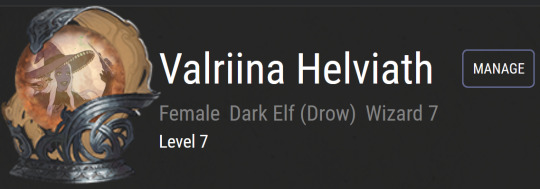

here are some frames from the Tasha's and Ravenlost pre-orders. the art is nice enough but...who wants these? i dont want these.
to get back to the subscriber frames, one might expect these to offer the more universal range of options. there are a couple nice vague frames, but the very few options are, once again, largely very specific, as season-themed frames. the subscriber frames include such all-applicable options as these.


you'll also notice a trend of heavily obscuring the character portrait itself (most obvious with my first two examples, and i promise there are other similar instances). overall it's just...frustrating that it's so difficult to find a frame that actually fits a character, nor obscures them beyond readability.
for so long, I've been baffled at the lack of a cosmetics shop where one can buy generic and specific frames for pocket change. It seems so obvious, and hardly outside dndbeyond's current setup. give me leafy frames for naturey characters, music note frames for musicians! frames themed after signature spells - magic missile, mage hand, crown of stars. frames designed after the types of damage, after different subclasses, after different weapons! frames with varying levels of complexity - both simple designs that can just match a character's colour scheme, and detailed animated frames!
when we got these frames, and I was estatic! It really seemed like a step in the right direction with simple, useable, non-obscuring frames. they're great!
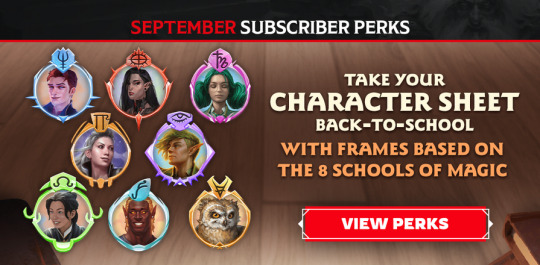
but since, though frames have gotten a little better in readability and specificity, we see no indication towards any change. occasionally, a book like the wildemount book will have some lovely generic frames, but then then the subscriber rewards are right back to weird and specific. can only keep fingers crossed, i suppose.
10 notes
·
View notes
Text
Social Model of Disability, HeroAca, Neoliberalism
Speaking of "Disability as individuality," as discussed in my book “We Who Hear New Voices” (Kodansha 2022), the Japanese manga/anime My Hero Academia (hereinafter referred to as HeroAca) calls “X-MEN” series-style mutant abilities "Quirk." In this work, too, "ability" is relativized by being called exactly "individuality". It is interesting to note, however, that in the world of HeroAca, those who do not have the ability Quirk ("normal" humans) are in the minority.
This relativization of ability and disability can be liberating in some cases. It frees people with disabilities from the oppression that ghettoizes and segregates them from society.
But it is not emancipatory in all historical contexts. In particular, it is especially no longer emancipatory in the present, where the former welfare state system is a distant memory and the neoliberal era has lasted for decades.
As we have seen, the line between normalcy and disability, or ability and inability, changes with history and society. The lines that were drawn during the welfare state era were, in some cases (such as the inhumane segregation of people with leprosy), exclusionary and oppressive to the disabled. In such cases, the movement to liberate the disabled became a movement to "deinstitutionalize" them. It became a movement to "reintegrate" the segregated and oppressed disabled into society.
What happened in the neoliberal era? The "deinstitutionalization" was pushed forward not by the minority movements, but by the neoliberal powers. This was a natural consequence of neoliberalism's advocacy of "small government" and its golden rule of cutting welfare and putting it in the hands of the market.
It was then that the above lines between normalcy and disability, ability and inability, were redrawn. In the trend toward de-welfare, marketization, and individual responsibility, reintegration into society in the name of employment is encouraged. In layman's terms, the pressure has increased for those who were once considered disabled to work in their own capacities, rather than relying on welfare.
If this is the case, it is only natural that heroes have become a "profession" in HeroAca. The "Quirk = ability" of the "heroes" in this work is to be able to work as a hero who belongs to an appropriate hero's office and has been made into a medium.
—Disability, Aging and Superheroes|"X-Men" series & "My Hero Academia, Shintaro Kono
23 notes
·
View notes
Text
A Comprehensive Guide to Mobile App Design in 2024
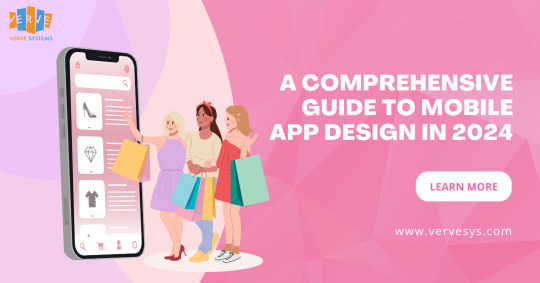
Table Of Contents
Introduction
What is Mobile App Design?
Importance of Creating a Custom Design
Latest Trends in Mobile App UI Design in 2024
Steps to Build the Most Effective App UI Design Process
How Can Verve Systems Help You with Mobile App Design?
Introduction
Mobile app design is a critical aspect of creating a successful and engaging digital product. As the mobile landscape evolves, it’s crucial for businesses and developers to stay abreast of the latest trends and design principles to deliver exceptional user experiences. In this comprehensive guide, we’ll explore the fundamental concepts of mobile app design, emphasize the importance of creating custom designs, delve into the latest trends in mobile app UI design in 2024, outline the steps to build the most effective app UI design process, and discuss how Verve Systems can assist you with your mobile app design endeavors.
What is Mobile App Design?
Mobile app design involves creating a visual and interactive interface for applications that run on mobile devices. It encompasses not only the aesthetics but also the functionality and user experience (UX). A well-designed mobile app considers user preferences, navigation, and the overall journey from the moment a user launches the app until they complete their desired actions.
Importance of Creating a Custom Design
1. Brand Identity:
A custom app design reflects and reinforces your brand identity. Consistent branding across your digital products helps in building brand recognition and trust among users.
2. User Engagement:
Tailoring the design to your specific audience enhances user engagement. A custom design allows for a user-centric approach, addressing the unique needs and preferences of your target demographic.
3. Competitive Edge:
In a crowded app market, a unique and aesthetically pleasing design can give your app a competitive edge. Users are more likely to choose an app that not only meets their functional needs but also provides an enjoyable and visually appealing experience.
4. Adaptability:
Custom designs can be adapted to the specific requirements of your app, ensuring that the user interface aligns seamlessly with the app’s functionality and purpose. This adaptability is crucial for creating a cohesive and intuitive user experience.
Latest Trends in Mobile App UI Design in 2024
As we step into 2024, several trends are shaping the landscape of mobile app UI design. Staying informed about these trends can help designers and developers create apps that feel modern and relevant:
1. Dark Mode Dominance:
Dark mode has become more than just a trend; it’s now a staple in UI design. Users appreciate the reduced eye strain and enhanced visual aesthetics offered by dark mode interfaces.
2. Microinteractions:
Microinteractions, such as animated buttons and subtle transitions, provide feedback to users, making the app feel responsive and interactive. These small design elements contribute to a more engaging user experience.
3. Immersive 3D Elements:
Leveraging 3D elements in mobile app design adds a layer of realism and immersion. Whether it’s interactive 3D models or depth-enhancing effects, these elements create visually stunning experiences.
4. Neumorphism:
Neumorphism is a design trend that combines elements of skeuomorphism and flat design. It involves using subtle shadows and highlights to create a soft, tactile appearance, giving apps a modern and futuristic feel.
5. Gesture-Based Navigation:
With the rise of edge-to-edge screens, gesture-based navigation is gaining prominence. Apps are increasingly adopting intuitive gestures for actions like swiping, pinching, and tapping, enhancing the overall navigation experience.
Steps to Build the Most Effective App UI Design Process
Creating an effective app UI design process requires careful planning and execution. Here are the key steps to ensure a successful outcome:
1. Define Clear Objectives:
Begin by clearly defining the objectives of your mobile app. Understand the target audience, the app’s purpose, and the desired user journey. This foundation will guide the entire design process.
2. Research and User Persona Development:
Conduct thorough research on your target audience. Develop user personas to understand their needs, preferences, and pain points. This information will inform design decisions that resonate with your users.
3. Wireframing and Prototyping:
Create wireframes to outline the basic structure and layout of your app. Progress to prototyping to visualize the flow and interactions. Prototypes provide a tangible representation of the user experience.
4. Iterative Design Process:
Adopt an iterative approach to design. Gather feedback at each stage, make improvements, and refine the design. This cyclical process ensures that the final product aligns closely with user expectations.
5. Responsive Design for Multiple Platforms:
Consider the diversity of devices and screen sizes. Implement responsive design principles to ensure a seamless and consistent experience across various platforms, be it smartphones, tablets, or wearables.
6. Testing and User Feedback:
Conduct thorough testing of the app’s design, functionality, and performance. Seek feedback from real users through beta testing and make necessary adjustments based on their insights.
7. Implementation and Development Collaboration:
Collaborate closely with developers during the implementation phase. A seamless partnership between designers and developers ensures that the envisioned design is translated into a functional and aesthetically pleasing app.
8. Continuous Improvement:
Post-launch, monitor user interactions and gather analytics. Use this data for continuous improvement, addressing any issues, and incorporating user feedback into future updates.
How Can Verve Systems Help You with Mobile App Design?
Verve Systems is a leading provider of comprehensive mobile app design services, offering expertise in creating tailored and innovative designs. Our team of skilled designers and developers collaborates with clients to deliver solutions that align with their brand identity and user needs.
Our Services Include:
Custom App Design:
We specialize in creating custom designs that reflect your brand and provide a unique user experience.
User-Centric Approach:
Our designs are crafted with a focus on user preferences and behavior, ensuring high levels of engagement.
Incorporating Latest Trends:
Stay ahead in the competitive landscape by leveraging the latest trends in mobile app design, keeping your app modern and appealing.
Collaborative Development:
We work closely with your development team to seamlessly integrate the design into the app development process.
Continuous Support and Improvement:
Our commitment extends beyond the initial design, with continuous support and a dedication to refining the app based on user feedback and evolving industry trends.
In conclusion, mobile app design plays a pivotal role in the success of any digital product. By understanding the fundamentals, staying updated on trends, following a robust design process, and partnering with experienced teams like Verve Systems, you can create mobile apps that not only meet user expectations but also stand out in the competitive app market.
Explore More — https://www.vervesys.com/ Contact Us — +1 (732) 402–6854, +91 79 4000 7881 Enquire Now — [email protected]
#mobile app development company india#mobile app design#mobile app development#mobileapp#web development#coding#business#mobile application development#ios app development#android app development#app developers#mobile app developers#mobile app design bd#mobile app developer company
6 notes
·
View notes
Text
Thoughts on Fashion Dreamer Day 1
Since the game received close to no marketing outside of Japan. I love fashion games and I want this one to do well too.
I played all the Style Savvy games before (almost 300 hours on each of then oof) but I ll try not to compare with Fashion Dreamer too much since the concept is different.
Apologies in advance for the mistakes (English is not my mother tongue)
What I like so far:
- Getting lookits from other players and giving some to them! I love seeing everyone's creativity
- There's SO many options to design a logo!! I spent too much time making them haha
- Visiting other's showrooms feels fluid. Its fun to just change try an outfit on a mannequin and walk to another showroom, like a carousel.
- The photo mode offers a lot of options. I like being able to take a picture anywhere. Also you can take vertical pictures for a better composition! Or just use the random button to have your muse in a dynamic pose.
- I love the idea of unlocking color palettes and using them to design clothes. There's some color theory in there... Also having reommendations is nice for indecisive people.
- It's rewarding to see the earrings I designed on the trends board. Then I found them again on a mannequin in another muse showroom. My muse tried the whole outfit (that was styled to match the the earrings I designed) and it was SUPER cute! I took pictures to remember that moment. I dont think there's any game that offers this kind of experience.
- Not having to manage a budget and getting items for free it is a fashionista dream haha.
- The animations and the models look nice! I was also afraid of EVE looking cold and empty (like the EDEN in Digimon Cybersleuth) but I was pleasantly surprised. I also havent seen anything clip though the models? (Anyone an expert on that lol?)
What I like less:
- Search function could be better. I want to be able to search by pattern and color!
- There's a bit of a performance issue when you have a lot of clothes. Hope this gets fixed in the future.
- Not being to zoom in clothing when dressing up is... Odd. Because you can zoom on the ones you design.
- Its super easy to get likes (I dont know if its the case for everyone). What bothers me is you get a notification for EACH likes. Im the kind of person that deacrivates most of my notifs on my cellphone because I find them intrusive.
- I hope they add runways, handbags and the possibility to share pictures with other players. And it would be fun to suggest makeup or hairstyles to other muses!
Game is pretty addicting, Im gonna play more for sure. I really needed a good fashion game for the Switch!! Its not Style Savvy but if I miss it too much, I can always power up my 3ds.
Maybe I ll write another post about Fashion Dreamer as I play more. Who knows :p Dont hesitate if you have questions!
9 notes
·
View notes
Text
2025 Rivian R1S and R1T Updates
June 7, 2024

Rivian has unveiled the second generation of its R1S mid-size SUV and R1T pickup truck for 2025, featuring significant updates under the hood and minor visual changes. Both models now offer an 850-hp Tri-Motor configuration and an improved Quad Motor setup with 1025 hp.
Battery Enhancements
The 2025 R1 models come with three battery options: Standard, Large, and Max. The Standard pack now uses a lithium-iron-phosphate (LFP) chemistry, simplifying service and reducing complexity. The Large pack’s usable capacity has decreased to 109.4 kWh, providing up to 330 miles of range. The Max pack offers up to 410 miles for the R1S and 420 miles for the R1T. Charging rates remain at 220 kW for all but the Standard battery, which is capped at 200 kW.
Powertrain Improvements
The default Dual Motor powertrain remains at 533 hp and 610 pound-feet of torque, while the Performance version maintains 665 hp and 810 pound-feet. The new Tri-Motor setup produces 850 hp and 1103 pound-feet of torque. The revised Quad Motor model now boasts 1025 hp and 1198 pound-feet of torque. Rivian claims the 1025-hp R1S can accelerate to 60 mph in under 2.5 seconds, with the 850-hp version doing it in 2.9 seconds.
Chassis and Technology Upgrades
Rivian has reworked the suspensions for improved ride and handling. New Pirelli tires and 22-inch aero wheels are introduced, along with updated lighting elements featuring animated light bars and an Adaptive Drive Beam. The electrical architecture has been streamlined from 17 to 7 control units, enhancing serviceability and reducing costs. The updated infotainment system now uses AI, and advanced driver-assistance features include 11 cameras and 5 radars.
Pricing and Availability
The 2025 R1S Dual Motor starts at $77,700, with the Large battery at $84,700, and the Max pack at $91,700. The new Tri-Motor model with the Max pack starts at $107,700. The R1T prices remain the same at $71,700 for the Dual Motor with the Standard battery, but the Large and Max pack versions are now $78,700 and $85,700, respectively. The Tri-Motor R1T with the Max battery starts at $101,700. The R1S Dual Motor is currently available, with the R1T following soon. The Tri-Motor variants are expected this summer, and the Quad Motor models later in the year.
Conclusion
Rivian’s 2025 updates to the R1S and R1T enhance range, performance, and technology. These improvements, along with a streamlined production process, position Rivian’s flagship models as more competitive in the evolving electric vehicle market.
Trending topics on google
Understanding the Recent H5N2 Avian Flu Case in MexicoTagged Rivian R1S and R1T new look
2 notes
·
View notes